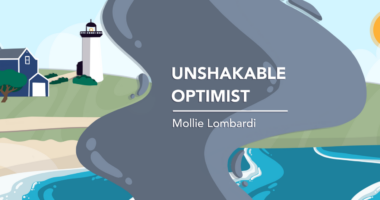Finding optimism — who knew? — in Joan Didion’s life with Parkinson’s
A reminder of the possibilities from a fellow writer with nonmotor symptoms

I loved the 2017 documentary “The Center Will Not Hold,”about the journalist, essayist, and author Joan Didion. She was a wonderful example of how one can make it to age 87 with Parkinson’s disease and still have a good life. I personally found it hopeful, as I could see myself in her shoes when I’m 87. It’s hard to stay positive and optimistic when facing the cycles, surges, and cynical thoughts that bombard me every day. So I get excited when I can share strong positive news.
If you watch the video, the first thing to focus on is how much she accomplishes despite the chronic illness — 26 books and many published articles in prominent magazines. Accomplishment is better than chocolate or vacations. It’s a dopamine booster that has power and longevity.
The second thing I focused on is how many times she talks about being the observer, and how others describe her journalism as tied to her skill as an observer. Her writings also reflect this skill. Put these two traits together — expert observer skills and hard work for accomplishment — and one has the basic ingredients for a successful Parkinson’s brain damage workaround.
The other thing the documentary emphasizes was her support relationships and how they were part of her healing journey.
Joan doesn’t write much about her experience with Parkinson’s disease, focusing more — in some popular, later works — on grief and loss. But she does say she was initially diagnosed with multiple sclerosis when in her 30s. Some people first experience Parkinson’s with symptoms that often mimic other syndromes. It starts years before it begins to get worse and is often initially misdiagnosed. This confusion is particularly true for the nontremor type of Parkinson’s. Joan and I have these experiences in common.
What was helpful to me in the video was seeing advanced nontremor Parkinson’s in a person who is intellectually active and a writer, like me. I can let go of the Muhammad Ali and Michael J. Fox images. I now have a brighter outlook and one more fitting to my brand of Parkinson’s.
It’s a nice fit — like that favorite jacket you throw on to fend off the chill of a fall morning. It’s hard to find much about this progressive chronic illness that leaves me with such feelings.
So much that’s written about Parkinson’s presents a disparaging forecast. This image of Joan’s life is a gentle breeze separating the gloomy clouds and allowing the sun to pour through. There is hope. There is possibility.
As I was reading Joan’s writings and articles about her, looking for anything describing her battle with Parkinson’s, I was surprised by its absence. She wrote about so many things that stirred up internal angst. The headline of Megan Garber’s posthumous review of Joan in The Atlantic called her the “bard of disenchantment.”
Certainly, living with Parkinson’s would qualify as life-altering. Given her heavy introspective writing style, often focusing on the exposed underbelly of life, I’m left in a quandary. This year the New York Public Library acquired Joan’s personal memorabilia. I’d hoped they would find something about Parkinson’s hidden in a lost trunk of dusty papers. I asked, but have yet to get a response.
I’m left on my own to speculate why she didn’t publish any article speaking directly about life with Parkinson’s. She was famous for stripping down to the bare nakedness of self-image in her writings. Maybe she had nothing to say because she saw no delusional mythos behind the social discourse about Parkinson’s.
Perhaps she didn’t want to face the gloomy portrait of this chronic illness that appears in almost every book written on the disease. She was a voracious reader, so I doubt she failed to delve into the literature. It’s clear from the documentary that Parkinson’s was affecting her life and that she had the nontremor form, which means that she experienced nonmotor symptoms.
To a person who is a skilled internal observer, these would’ve been obvious. She just didn’t write about it.
My frail conclusion is that she didn’t see the need to write about it because many of the nonmotor effects are invisible, not just to the outside observer, but also to the inner explorer. This is the nature of damage to the midbrain. Yes, she was introspective, but not in the way of Zen meditation, and that’s what’s needed to get past the cloak of invisibility.
To our readers, we announce that Dr. C’s “Possibilities with Parkinson’s” columns will conclude on April 14. Our final column next week will share our thoughts on transition and the future ahead.
Note: Parkinson’s News Today is strictly a news and information website about the disease. It does not provide medical advice, diagnosis, or treatment. This content is not intended to be a substitute for professional medical advice, diagnosis, or treatment. Always seek the advice of your physician or another qualified health provider with any questions you may have regarding a medical condition. Never disregard professional medical advice or delay in seeking it because of something you have read on this website. The opinions expressed in this column are not those of Parkinson’s News Today or its parent company, Bionews, and are intended to spark discussion about issues pertaining to Parkinson’s disease.







Mike
Dr.C.
Your columns have been a staple for me as I grow in my belief that Parkinson’s has been a gift provided by my Higher Power. I have been practicing ‘Mindful Movement’ since you named it. For me a Critical element of my Brain Rewiring has been to realize that first I must take ownership of this dreaded condition. Only then can I share the burden. Dr.C. and Mrs. Dr.C. my hope is that we will meet somewhere down the road. I cannot thank you enough for the Mental Stimulation you have provided for all of us in your Community.
Blessings, Mike
Ron
Thank you, Mike, for your eloquent remarks to Dr. C about his incredible contributions to our community. Stay well, everyone.
Jan fredsbo
Dr. C!
Dearest Dr. C. and mrs. C.
Sigh. I just mentioned to a friend how fortunate I have been to have been somehow led to your writings. How much your writings have taught me about the different stages my husband go through. If I
It wasn't for you I simply would not know "how to" be around this whole experience of illness and the cycle about and around it. Words are poor somehow but please receive the greatest heartfelt biggest Thank You for leading the way. Your writing and way of life is simply so inspiring and have brought so much peace to our lives with this illness I do not know really how to thank you (enough)
Teary eyed to hear that it will have an end and grateful that we "met" just in time. You have made a big impact.
May you continue to be inspired and may your life continue to be uplifted by the gifts of God you so generously share with us all. Thank you Dearest Both of you. From the bottom od our Hearts.
From Janne and Mr. Anders
William Palmer
Thank you, Dr. C. Your columns have helped me--I have saved them. Regarding Joan Didion, I wonder if you contacted her nephew Griffin Dunne, if he might shed more light on Joan's PD.